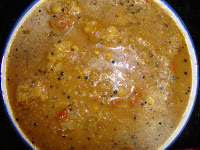
Vegetable Balls
It is quite natural to fancy cutlet sort of snack on a nice autumn day. But little over four months post childbirth the sight of my tummy just did not let me indulge. I had gone far enough to get the vegetables boiled and had to get on with the rest of the preparation. How do I enjoy a recipe with crispy outside and soft inside spiced up with great flavours without the guilt? As always, mom’s idea came in handy. It was good in more than one way because it not just met my requirement of using very little oil but also put to use a cooking utensil that was otherwise seldom used. The magic mantra was the kuzhi paniyara koodu (the dish in which kuzhi paniyaram is made). I love the paniyarams and was sure I wanted this dish in my kitchen. My husband was concerned I would clutter the house and hence I had to be cheeky to get this. I went shopping in East Ham with my brother. I was about 4 months pregnant and remember not just enjoying the masala dosai and pongal in Vasantha Bhavan but also my victorious shopping. For those of you who have not seen kuzhi paniyara koodu before, here is a picture of mine...
Now for my recipe...
1 cup cubed boiled potatoes
½ cup green peas boiled
½ cup carrot diced and boiled
2 green chillies
1 tablespoon finely chopped coriander leaves
Chilly powder (optional)
1 teaspoon coriander seed powder (dhania powder)
1 teaspoon cumin seed powder (jeera powder)
Turmeric powder
Salt as required
Breadcrumbs
Cooking oil
In a pan, add about 1 teaspoon oil and put all the powders except chilly powder and green chillies and fry forcouple of minutes on a low flame. Combine all the boiled/steamed vegetables with the powders and mash them. Add chilly powder if desired, salt as required and add the coriander leaves. It is important that you make the balls when the vegetables are still hot else they will not retain shape. To help withstand the heat keep wetting your hands in cold water. Make balls to the size that will go in your kuzhi paniyara koodu. Once you roll to form the ball, roll it in breadcrumbs so each ball is uniformly coated. In the mean time keep the ‘koodu’ on the stove and heat on high flame. Add less than a teaspoon of oil in each ‘kuzhi’ and reduce flame to medium. Once the oil is hot, start putting the balls in carefully. Carefully keep turning the balls so they are uniformly cooked. When you put the top side bottom, put less than a teaspoon oil so that this side can also get cooked well. Serve hot with ketchup !
You could use other vegetables of your choice. Be careful not to add too much carrot or peas as they can make the dish a bit sweet. You may want to add some grated ginger. Enjoy, guilt free!!












